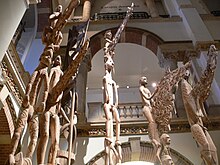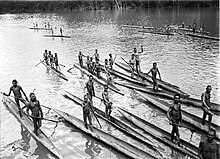Religion and philosophy among the Asmat people
The core of the religion and philosophy of the Asmat is the constant effort to maintain balance in all relationships. Imbalances - such as village quarrels or lamentable fatalities - disturb the harmony in the cosmos and must be balanced out in order to restore the necessary harmony . Ultimately, retaliation is never demanded, but compensation. Manipulation, cunning and cunning outbidding of the Asmat among each other are permitted.
Philosophical approach
Unlike in western religions, the Asmat do not ask about the reasons for the origin of the universe or about a divine creator . A pre-existing nothing or chaos is not filled or ordered. These questions are irrelevant. The cosmos has always been there. He turns out to be inspired, because many myths tell of people who transform themselves into animals and vice versa. Celestial bodies and earth elements carry spiritual energies and can be used to survive the struggle for survival and emerge stronger from it. Since within this context human existence is understood as an integration into the ancestral line and not an end in itself of individual existence, the worldview lacks the idea of creation .
The dichotomous discourse of the western world is completely alien to the Asmat people. No distinction is made between the spiritual and the profane . Rather, every human activity is directly related to the entire cosmos. Man and the cosmos are holistic in nature. The cosmos is in equilibrium. Disturbances must be balanced in the understanding of the Asmat. In addition to reproduction and survival, happiness, health and prestige are in the foreground of a successful outlook on life. Prestige is achieved through success with women, in war and in hunting. This goes hand in hand with power that is preserved and especially valued after death. For this it is always necessary to tap into spiritual powers.
Religious approach
In the above-mentioned flowing equilibrium there are two worlds of thought for the Asmat. On the one hand, they believe in the “ earthly world ” that reveals itself in the form of their communities, as a family , clan , lineage , village (group) and cultural context. Next to it is the “ transcendent world ”, which also includes the world of the living, but on an intermediate level takes into account the influential souls of the deceased that still exist in the vicinity. On a third level, the world of the ancestors living in the hereafter is recorded, who send their spirits back to the earthly in the ritual .
The earthly life within this conceptual “earthly world” begins with the cultural birth in the community of the village, the initiation . The decisive factor is therefore not the physical birth as the beginning. Earthly life ends with death. Before entering the world of the ancestors, there is another path to be taken, death is, as it were, "lives" through, souls wander. The souls have reached the intermediate level. In the world of the ancestors, the carefree life begins in the hereafter and is the phase of restitution and then the return to the world as a spirit. With the physical birth of a child, the mythical transformation from spirit to human life takes place. The spirit that returns earthly in animal form from the hereafter penetrates the human being (fertilization process). This closes the arc of the “transcendent world”.
Infant mortality in this context is interpreted as the return of the spirit to the hereafter.
The earthly world is understood as "asmat ow", the world of the dead as "damer ow", the world of the ancestors as "ji ow". The "damer ow", the omnipresent souls of the dead, influence or even determine luck and misfortune in the form of war, natural disasters or illness. For this reason, they are remembered in the rite, primarily in the ancestral stake festival . Music (drum sound and singing) and artistic creation manifest themselves in brilliant form, because the souls of the dead are made present in every carefully carved object. These objects are not symbols, images or replicas of the souls of the dead, they are understood as living reality. In addition, the effect extends to animate and inanimate natural phenomena, such as animals, plants, fireplaces, weapons and tools, thunder and river bends. The mask festival has a similar meaning .
The souls of the dead not only offer protection, but they demand, for example revenge for headhunting, where they demand homage and sacrifice. This penetrating power of the souls of the dead can be difficult for a village community, which is why the urgent signal in the ritual is required (ancestral stake festival). Interpretation approaches also suggest that the souls of the dead in the intermediate worlds (ainamipits) face a difficult path into the ancestral kingdom and that they must therefore be helped to advance, in turn in cyclically recurring rituals . The fact that the spirits visit the living is of great importance, because it reduces fears and removes insecurities of village coexistence. Magical elements and taboos are omnipresent in the Asmat world.
Physical admission
The Asmat believe that people are born with two inner, life-giving forces. The power of yuwu is the physical power center. ndamup is a bilocal soul center that exhibits excorporation properties. The Asmat see ndamup as the "shadow" of the real person. These shadows are able to separate from the real person in sleep, to wander about and transform themselves. Crocodile attacks on villages are attributed to such events. Both forces are present from the birth of man.
In the personal development of people, a third force, joined by a friend . It is understood as the spirit of an ancestor who helps the still nameless to develop his personality . The ancestor's properties, abilities and intellectual powers are passed on to the adolescent. From a biological point of view, the ancestor finds his goal in the path of reincarnation. Disguised as a green tree frog, he chooses a woman in the sago of the village women, on whose right shoulder he jumps. Their descendants thus infallibly receive the ndet name of the ancestor. Several nd can come together in one person and give you a special increase in strength.
The Asmat know other spiritual powers like samu . They are regularly harbingers of doom and death. They appear in advance when an Asmat begins to behave abnormally. He empties his bowels into the dugout canoe , eats raw fish or destroys his spears.
Myths
There are legends in which mythical animals, endowed with extraordinary powers, and also snakes were able to free people from hopelessness and darkness. Many of these legends are discussed in contradiction among the individual Asmat groups. Other legends are shaped by astonishing initiatives by women (to be emphasized are: Tjowotsjbiwar and Mbunar ), who ensured decisive life support. It was not about creation accounts, but reminiscences of once small (er) ethnic groups who described and preserved the struggle for survival.
The only (apparent) beginning of creation is the legend of Fumeripits , who brought wooden carved figures to life. Although this myth is known in parts of the Asmat settlement area, there is agreement that it was not Asmat, but Mimika who created it. The legend has to be interpreted in the light of the animistic ethnic religion , where myths of the incarnation of a bird in humans also find their place.
See also
literature
- Alphonse A. Sowada: Religious and philosophical basic concepts of the Asmat . In: Gunter and Ursula Konrad (eds.): Asmat: Myths and Rituals - Inspiration of Art . Venice 1995, ISBN 88-7077-035-4 (main source for the article).
- Gunter Konrad, Ursula Konrad (with the participation of Adam Saimas, Petrus Wer, Miguel Bingumeces and Soter Sokerau): Asmat: Myths and Rituals. Inspiration of art. Erizzo, 1995.
Remarks
- ↑ Preliminary remark: Following the main features of the explanations of the ethnologist Hanns Peter in his analysis of the culture of the Gargar ethnic group, the question is allowed to what extent the terms “philosophy” and “religion” can aptly reflect the complex of views. A clear distinction between the terms “magic” and “religion” cannot be made. It may actually be helpful to differentiate between whether the ideas are related to cultural heroes or creators, or not. With the Asmat, the question appears to be answered more easily in favor of the chosen lemmatization than with other ethnic groups in the cultural area (cf. Iatmul / Marind-anim ).
- ↑ Alphonse A. Sowada: Religious and philosophical basic concepts of the Asmat. In: Gunter and Ursula Konrad (eds.): Asmat: Myths and Rituals - Inspiration of Art. Venice 1995, ISBN 88-7077-035-4 .
-
↑ a b c d e f
Volume 2, contribution by Gunter Konrad and Yufentius Biakai: On the culture of Asmat: Myth and Reality, pp. 465–509
Mark Münzel : New Guinea use and interpretation of the environment . Ed .: Department for Culture and Leisure. tape 1 + 2 . Museum für Völkerkunde, Frankfurt 1987, ISBN 3-88270-360-1 , p. 725 . - ↑ A. Kuruwaip: The Asmat Up Pole (1974)
- ↑ G. Zegwaard, Name giving among the Asmat (1972)
- ^ Alphonse A. Sowada, The Saga of Tjowotsjbiwar (1983)
- ^ Alphonse A. Sowada, The Epic of two women (1983)
- ^ Alphonse A. Sowada, The Saga of Fumeripits from Biwar Laut
- ^ G. Zegwaard, The story of Fumeripits (1974)
Web links
- Bibliography (English)
- Asmat Art Collection Gallery Berlin

